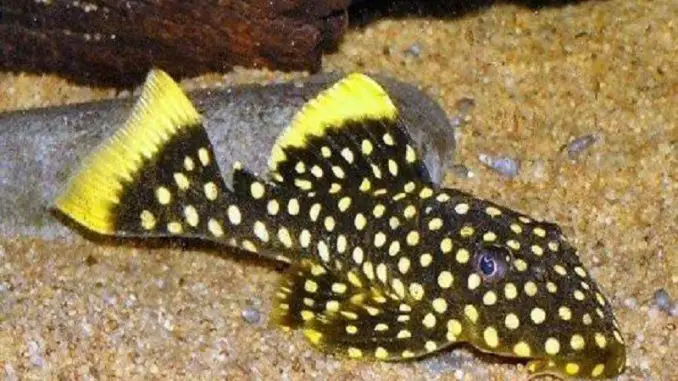
If you’re looking for a fish that will really make your community aquarium pop, the gold nugget pleco is a real showstopper.
A stunning freshwater fish of the plecostomus family, the gold nugget pleco stands out for its unique and lush looks, and as an added bonus, they are easy to care for. Some of the more gorgeous freshwater fish are challenging to care for, but not that is not the case with these large and lovely fish.
Gold nugget plecos hail from South America and are peaceful tank mates that will get along well with other members of your aquarium community.
TABLE OF CONTENTS
Gold Nugget Pleco Facts & Overview
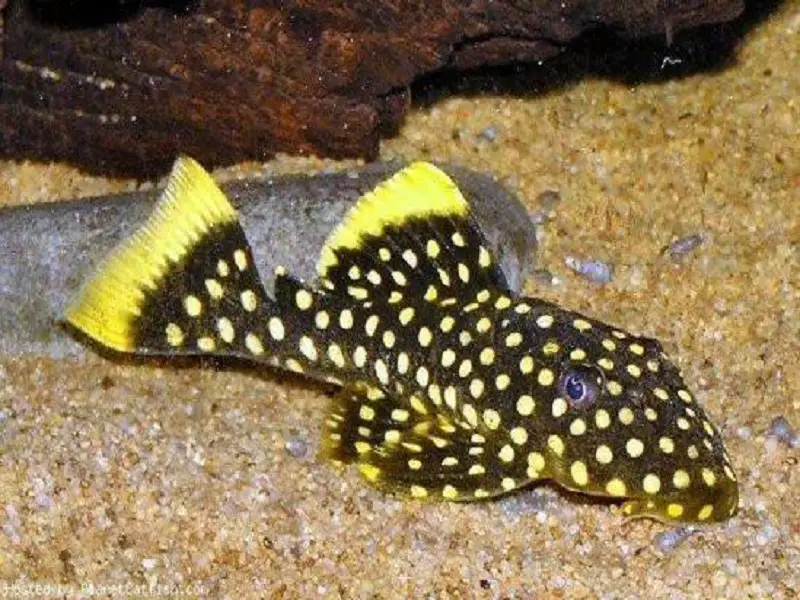
| Category | Rating |
| Care Level: | Medium |
| Temperament: | Peaceful |
| Color Form: | Dark green to black with yellow dots |
| Lifespan: | 4-5 years |
| Size: | 6-9 inches |
| Diet: | Omnivore |
| Family: | Loricariidae |
| Minimum Tank Size: | 55 gallons |
| Tank Set-Up: | Freshwater with plants and rocks |
| Compatibility: | Peaceful community, territorial with other plecos |
Originating in South America, the Gold Nugget Pleco, scientific name Baryancistrus xanthellus is found mainly in Brazil, but also in Venezuela. They populate the tributaries of the Amazon River and, therefore, will appreciate a lush aquascape with plenty of caves and driftwood that mimic their habitat of origin.
They also prefer dimmer lighting, which is similar to their conditions in the wild, so don’t splurge on a fancy light. The plants and caves will also help filter out any excess light.
Gold Nugget Plecostomus, what we call Pleco for short, has been known to the aquarium hobby since 1981 when it first arrived in Great Britain via export. This fantastic suckermouth catfish is part of the Loricariidae family; you may see them advertised as Golden Nugget Plecos, though dropping the “en” is more common.
Additionally, you’ll often see Gold Nugget Plecos called by their letter and number identification. If you see an aquarium fish offered for sale identified with L018 or L-18, that is the Gold Nugget Pleco. There are so many different types of freshwater catfish that this letter and number system helps to distinguish between the different types.
However, all you really need is a glance at this yellow polka-dotted fish to figure out that you are looking at a Gold Nugget Pleco. Other varieties of the Gold Nugget Pleco are L085 (very similar to L018 and with medium-sized dots); L177 with large dots; and L081 with tiny dots.
Lifespan
In captivity, Gold Nugget Plecos live for about 5 years when they are provided with optimal conditions. They will live a little bit longer in their natural habitat.
Size
Gold Nugget Plecos will reach a length of 6-9 inches (15.2-22.9 cm) in your community tank. In the wild, they will grow bigger, up to 13 inches (33 cm).
Typical Behavior
Like other plecos, Gold Nugget Plecos are bottom dwellers who live along the bottom portion of your aquarium and scavenge for food, snacking on algae and leftover food that drops down from middle and top dwellers.
These fish are mellow and shy, unlikely to bother others in the aquarium community; they do their thing and mind their own business. However, they do get territorial with other plecos, so it’s a good idea to house one type of catfish in your community tank.
It’s not that they are super aggressive; it’s just that if there are too many bottom feeders, they don’t have enough room and will advocate for their own space. As long as they can carve out their own little zone, they will not bother any other kind of fish.
They are also helpful to the tank as they will eat some of your excess algae.
The larger the tank, the less likely it will be that you will witness any kind of territorial struggle. However, unless you have room for a really large aquarium, it is unlikely you will have enough space for multiple plecos when the Gold Nuggets are on the edge of 10 inches (25.4 cm).
In the absence of struggle, Gold Nugget Plecos will keep to themselves, finding hiding places in the caves and driftwood that you provide, and eating algae off the inside glass of the tank. You will find that they spend much of the day hiding, and you may have to wait until nighttime to really see the party kick into gear.
One other note: Although Gold Nugget Plecos stick to the bottom level of the aquarium, you want to ensure a tight-fitting lid so they don’t try to escape.
Appearance
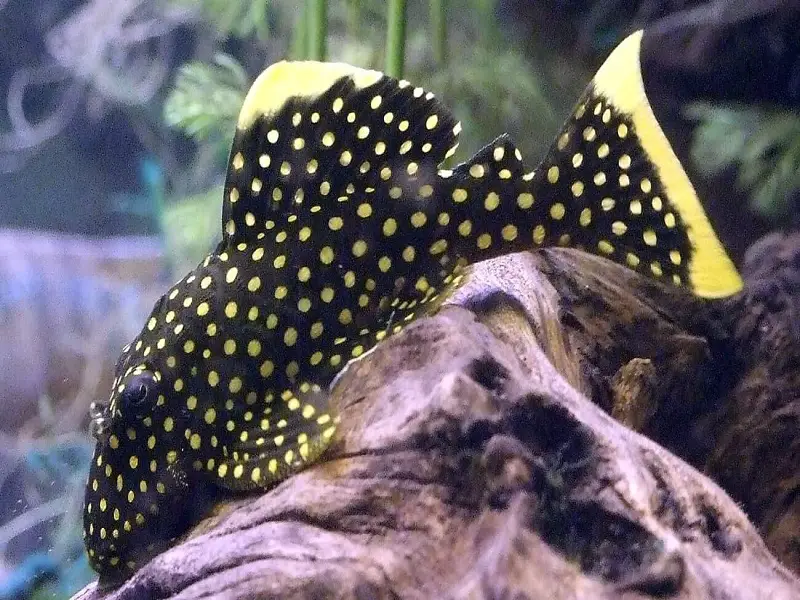
Let’s face it–some catfish can be pretty drab looking, and the appeal of the suckermouth is certainly not universal. But the Gold Nugget Pleco looks like it could be swimming down the catwalk in the latest fashion show. With a dark green to black body, it’s covered in uniform-sized and spaced yellow dots. They are also framed with yellow borders at the end of the caudal and dorsal fins.
They are really spectacular to look at!
While their coloring is unique, their build is 100 percent pleco. In addition to the aforementioned suckermouth, they have the angled head that faces down for proper scavenging. Their bodies are thinner down by the caudal peduncle and wider from the pectoral fins to their eyes.
Speaking of pectoral fins, Gold Nugget Plecos have large ones, and they have a backward point. Their caudal fin is a little larger than their dorsal fins, which look like fans.
As I mentioned earlier, these fish are about 6-9 inches (15.2-22.9 cm) in captivity, depending on the conditions that you provide. If you invest in a quality filtration system and provide them with clean water and a sufficient diet, their growth and coloration will be superb.
Additionally, offering a larger tank will increase its growth capacity. A smaller tank with many other inhabitants will discourage growth; that is why they grow to be up to 13 inches (33 cm) in the wild. We have established that a 55-gallon tank is a minimum size for Gold Nugget Plecos, but if you are keeping multiples and have other community inhabitants, a 100 or 150-gallon tank will give them the freedom they need to grow to their full potential.
Habitat and Tank Conditions
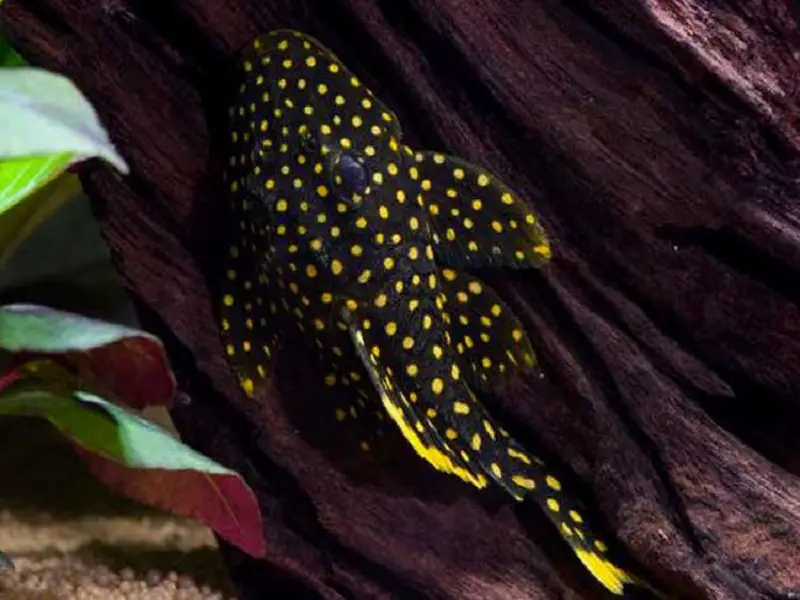
Taking my recommendation of a 55-gallon minimum tank size, it is important to keep in mind that these are larger sized fish that need the room. You might think a smaller tank will suffice due to the fact that they will stay on the bottom of the tank and because they are not fast swimmers like some other mid and top dwellers like hatchet fish, their substantial size requires a larger tank.
You can fill spaces in the mid and top levels of the tank to fill the extra space afforded by the supplemental gallons. Remember, too, that Gold Nugget Plecos like hiding places, so you’ll need space for decorations, caves, driftwood, and plants.
Like all aquarium fish, Gold Nugget Plecos are more likely to thrive when they are provided with habitat conditions that are similar to their natural habitat in the wild.
Author’s note: Even fish bred in captivity who have never actually been in the wild have an innate desire for their natural environment. But Gold Nugget Plecos are not bred in captivity, so they are actually transplanted from the wild, making their need for their natural habitat paramount.
Substrate
Gold Nugget Plecos will do best with a soft, sandy substrate. The substrate is not the most important consideration for mid and top-level fish, but for bottom dwellers like Gold Nugget Plecos, it is really important.
The choice of soft sand is twofold: first, it is the closest match to their home environment. Second, since they are scavengers, the bottom of their bellies are going to constantly be scraping the substrate, and if you choose rough gravel or rocks, they are likely to be injured, causing stress and possible infections from cuts.
Plants
Lush planting also serves multiple purposes for your Gold Nugget Plecos:
- Detritus from the plants serve as a source of nutrition
- Plants filter out excess light that is bothersome to Gold Nugget Plecos
- Greenery is a great hiding place
- Simulation of natural habitat minimizes stress
- Vegetation means healthier water
Pro-tip: There’s no need to choose plastic plants for these fish. Gold Nugget Plecos can handle live plants. They will not munch on live plants, only on the dead droppings.
Decorations
For Gold Nugget Plecos, it’s all about hiding places. We have mentioned the decorations, caves, driftwood, and plants that provide them with the coverage they need. Just remember that you’ll need larger caves than you would for other fish.
Filter
Choose a high-quality filter. Gold Nugget Plecos are sensitive to dirty water, and you want to make sure that you keep a super clean tank to eliminate their stress and ensure healthy fish. Besides keeping the water clean, read on to find out the other water specifications for these catfish.
It’s also important to remember that since Gold Nugget Plecos are larger catfish, they will produce more waste, meaning you will need to work harder to keep the tank clean.
Water Conditions
Gold Nugget Plecos are not super finicky about their water conditions, so even a novice hobbyist won’t have too much trouble. The catfish are not the most robust aquarium fish out there, but the parameters are less of an issue than regular water testing and changes.
I indicated a medium level of care since Gold Nugget Plecos are most susceptible to problems when you first introduce them into a tank, whether it is a new or established community. During the adaptation time, it is especially important to test every day or two during the first couple weeks of the Gold Nuggets being in a new tank.
Once you have maintained stable conditions, you can reduce the testing to every few days. You should also get in the habit of regular partial water changes.
To ensure optimal conditions for your Gold Nugget Plecos, you should aim for the following parameters:
- Water temperature: 73°F to 79°F (22.8°C to 26.1°C)
- pH levels: 6.5 to 7.5
- Water hardness: 5 to 15 dH
What Size Aquarium Do They Need?
I recommend a minimum of a 55-gallon aquarium for Gold Nugget Plecos. Larger is better, as I discussed before.
I would say go as big as your space will accommodate. Squeezing them into a smaller space will affect their quality of life, cause more stress, stunt their growth, increase the risk of illness, and shorten their lifespan.
Tank Mates
The best thing you can do for your Gold Nugget Pleco is to keep them away from other plecos. They are very territorial and don’t do well with other catfish. In general, you’d do better to fill the mid and top levels of your tank with other species and let the Gold Nuggets have free reign on the bottom.
That said, they do fairly well with different species of snails, but if you aren’t feeding them enough, Gold Nugget Plecos may have them for a snack!
Suitable tank mates for Gold Nugget Plecos:
- Apistogramma
- Celestial Pearl Danio
- Dwarf Gourami
- Ember Tetra
- Goldfish
- Honey Gourami
- Neon Tetra
- Pearl Gourami
- Rummy Nose Tetra
- Sparkling Gourami
Keeping Gold Nugget Plecos Together
Just as Gold Nugget Plecos can get territorial with other species of plecos, they can also get aggressive with their own species. Again, the larger the tank, the more space each Gold Nugget will have to claim as territory, and the less aggression you will see. I wouldn’t recommend more than a pair of Gold Nugget Plecos in a tank, though.
Diet
We have already established that Gold Nugget Plecos will eat algae from the tank walls, detritus that falls off of plants, and leftover food that floats down from top- and mid-level fish meals. This information should allow you to deduce that Gold Nugget Plecos are not picky eaters.
If they don’t find enough food on their own, you can supplement it with flakes and pellets. You will have to provide the meat element of their diet. They are omnivores, but they need meaty proteins. You can offer them bloodworms, brine shrimp, or tubifex, or even carnivore pellets.
The bloodworms, brine shrimp, and tubifex should be considered a treat that you can offer every other day. Offering Gold Nugget Plecos a wide variety of nutrition sources is beneficial for their health and their coloring.
You can also supplement their green intake with small pieces of blanched cucumbers, shelled peas, and zucchini.
Pro tip: Although Gold Nugget Plecos are flexible about what they eat, you do have to find the right balance between keeping their tank clean and leaving enough algae for them to eat.
As with all aquarium fish, avoid overfeeding for two main reasons:
- You can make your fish sick
- Leftover food deteriorates and compromises the integrity of the water.
As nocturnal catfish, Gold Nugget Plecos prefer to eat later, so plan their meals for the evening hours. You may need a nightlight if you want to watch them eating.
Care
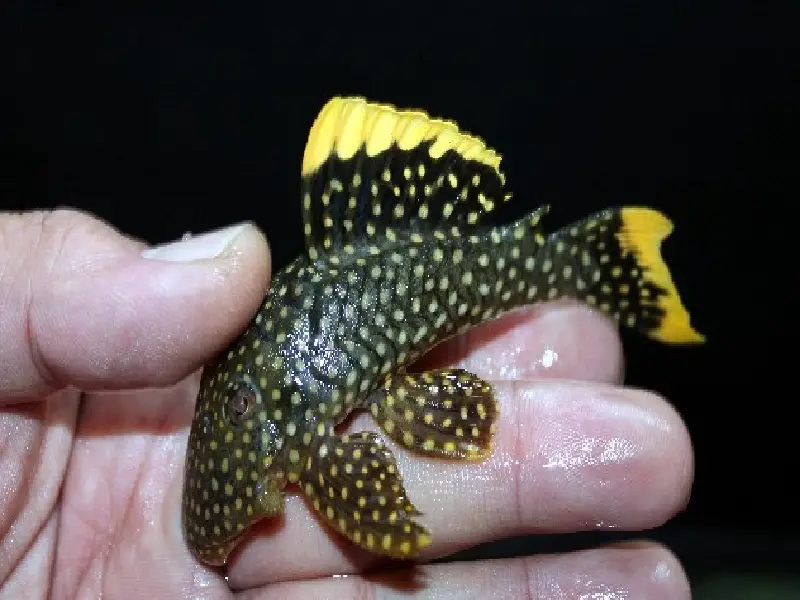
All aquarium fish should be provided with an environment in which they can thrive. This means maintaining the water parameters and conditions I detailed earlier a varied diet, and most of all, reducing their stress.
For Gold Nugget Plecos, you can limit stress by keeping them away from other plecos and providing them with plenty of space.
These catfish are on the pricier end of the freshwater fish offerings, and you want to make sure that you provide optimal chances for your Gold Nugget Plecos to achieve the longest lifespan possible and be joyful in the community you have created.
Gold Nugget Plecos are not as susceptible to disease as some other species, but you should watch out for ich and other parasitic diseases; if your suckermouth catfish turn up with ich or another parasite, treat with over the counter medication.
Keeping the tank clean and stress levels at a minimum will go a long way to prevent such parasites.
While we are talking about health, I would note that Gold Nugget Plecos are also susceptible to infections that develop from injuries, so keeping them away from potential fights with other plecos and providing a soft substrate are two ways that you can be proactive in protecting your Gold Nugget Plecos.
If you notice your Gold Nugget Pleco’s colors fading, it is likely that he or she is stressed. However, if the color does not return, test the water parameters to make sure the conditions are not harming the fish.
Breeding
Gold Nugget Plecos are not good candidates for home breeding. I have seen some articles detailing methods of home breeding, but the truth is that these suckermouth catfish have not been successfully bred in captivity.
It would be unfair and stressful for the Gold Nugget Pleco if you tried to breed them at home, so I strongly caution against trying such a risky and fruitless venture.
Are Gold Nugget Plecos Suitable for your Aquarium?
If you’re a fan of big fish, I highly recommend the yellow-spotted Gold Nugget Pleco. They provide a splash of color to your community tank. If you have an established tank that’s big enough, and you have abundant mid-and upper-level fish and a sparse bottom level, the Gold Nugget Pleco may be just the suckermouth catfish to complete your community aquarium.
If you are looking to establish a new community and have enough space for at least a 55-gallon tank, the Gold Nugget Pleco will definitely spice things up.
However, if your tank is already pleco-rich, hold off on getting a Gold Nugget Pleco–unless you have enough room for a second tank.
Do you find Gold Nugget Plecos to be some of the coolest looking aquarium fish? Share your thoughts in the comments below.
FAQ
Do I need to give my Gold Nugget Pleco algae wafers?
Gold Nugget Plecos should be able to help themselves with all the algae they need from the sides of the aquarium.
If you do not see any algae at all on the sides of your tank, you may be doing too good a job of keeping it clean. In the wild, Gold Nugget Plecos rely on the algae they find in the Amazon River tributaries, so it is important that they have some actual algae to scavenge from the home tank.
Do I need to have a separate breeding tank?
I do not recommend attempting to breed Gold Nugget Plecos. It has not been successfully achieved. There are many other aquarium fish for which hobbyists have established successful breeding in captivity, so I would recommend trying with some of those, but not Gold Nugget Plecos. Try guppies or certain types of cichlids.

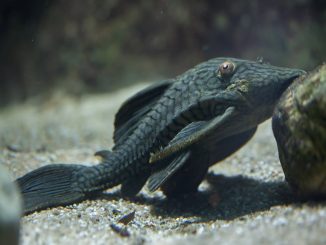
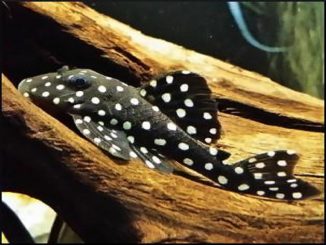
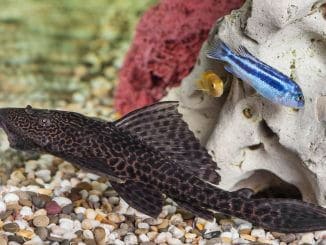
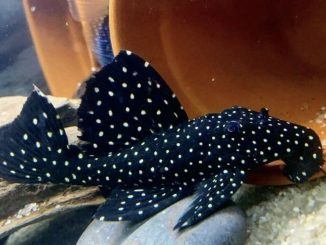
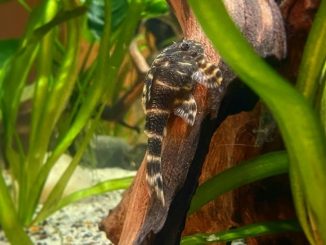
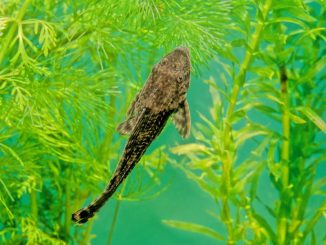
Hi Robert,
Thank you for an excellent article on one of my favorite fish ever. I’m very interested in adding one to my 150 gallon tank. However, one aspect that I’ve been unable to find information on is in regard to their conversation status.
I’m not willing to add a gold nugget pleco if their status is declining due to the aquarium trade, or if their capture process is doing significant damage to their environment. Any information you could provide about this would be very helpful.